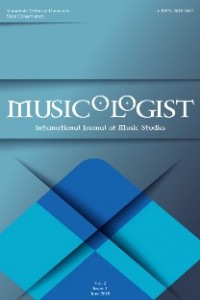Abstract
References
- Bosio, Gianni. Longhini, Clara. (2007). 1968, Una Ricerca in Salento. (A Research Study in Salento.) Calimera: Edizioni Kurumuny
- Carpitella, Diego. (1985). Forme e Comportamenti della Musica Folklorica Italiana: Etnomusicologia e Didattica. (Forms and Behaviours of Italian Folkloric Music: Ethnomusicology and Didactics). Milano: Centro di Ricerca e Sperimentazione per la Didattica Musicale
- Daboo, Jerri. (2010). Ritual, Rapture, and Remorse; A Study of Tarantism in and Pizzica in Salento. Bern: Peter Lang AG, International Academic Publishers.
- Falangone, Francesca. (2017). “‘Cantamu Queddha…’: Pratiche Collettive e Iniziativa Individuale nel Canto Tradizionale Salentino.” (“Let’s sing that one…”: Group Practices and the Individual Initiative of Traditional Salentine Singing) Palaver, (6)-2: 145-164. http://siba-ese.unile.it/index.php/palaver/article/view/17751/15117.
- Jordania, Joseph. (2006). Who Asked the First Question?; The Origins of Human Choral Singing, Intelligence, Language and Speech. Tbilisi: Logos. http://citeseerx.ist.psu.edu/viewdoc/download?doi=10.1.1.470.3973&rep=rep1&type=pdf. PDF.
- Muci, Dario. (2008). Canti Polivocali del Salento, Nardò/Arneo. (Multi-part songs of Salento, Nardò/Arneo.) Calimera: Edizioni Kurumuny
- Santoro, Vincenzo. (2009). Il Ritorno della Taranta; Storia della Rinascita della Musica Popolare Salentina. (The Return of the Taranta; A History of the Salentine Folk Music Revival). Rome: Squilibri.
- Shetuni, Spiro. (2001). J. Albanian Traditional Music; An Introduction, with Sheet Music and Lyrics for 48 Songs. Jefferson: McFarland and Company, Inc. Publishers
- Bosio, Gianni. Longhini, Clara. (2007). 1968, Una Ricerca in Salento. (A Research Study in Salento.) (CD). Calimera: Edizioni Kurumuny
- Lomax, Alan. Carpitella, Diego. (2002). Puglia, the Salento. Cambridge, Mass.: Rounder Records
- Muci, Dario. (2008). Canti Polivocali del Salento, Nardò/Arneo. (Multi-part songs of Salento, Nardò/Arneo.) (CD). Calimera: Edizioni Kurumuny
- Audio Example 1. Lomax, Alan. (1954) La Carrozza è Già Arrivata. (The carriage has arrived already.) Recorded in Martano, Italy. August 13, 1954. Cambridge, Mass.: Rounder Records.
- Audio Example 2. Bosio, Gianni. (1968). Ci dice ca Livornu non è Bella? (Who says that Livorno isn’t beautiful?) Recorded in Torrepaduli, Italy. August 15, 1968..Calimera: Edizioni Kurumuny.
- Audio Example 3. Morello, Mario. (2015). Quannu te Llai la Faccia la Matina. (When you wash your face in the morning.) Recorded in Nardò, Italy. October 29, 2015. Toronto, Canada: Private Collection.
Shift and Transformation in Salento: Investigating Change in the Polyphonic Structure and Performance Practice of Canti Polivocali in Southern Puglia
Abstract
This paper will focus on documenting change
and transformation of polyphonic singing in the Salento region of lower Puglia
(southern Italy), based on a comparative analysis of early field recordings and
recently collected materials. Cantipolivocali (“multi-voiced songs”), the
repertoire of vocal polyphony distinct to the Salento region, was once widely
practiced throughout the region with subregional musical dialects and a rich
repertory of local variants. This rich musical activity was captured in early
field recordings by the first major wave of researchers in the field, notably
between the mid-1950s to late 1960s by ethnomusicologists Diego Carpitella,
Alan Lomax, Gianni Bosio, and Clara Longhini. After mass emigration and
significant changes in traditional music’s positioning in contemporary Italian
culture, the tradition of this singing in Salento has shifted considerably in
both its polyphonic structure and how it is situated in cultural spaces. By
comparing recordings of the aforementioned early collections with field
recordings recently collected by the author through analysis, this paper will
aim to document these changes and identify the significant transformations of
cantipolivocali in Salento.
References
- Bosio, Gianni. Longhini, Clara. (2007). 1968, Una Ricerca in Salento. (A Research Study in Salento.) Calimera: Edizioni Kurumuny
- Carpitella, Diego. (1985). Forme e Comportamenti della Musica Folklorica Italiana: Etnomusicologia e Didattica. (Forms and Behaviours of Italian Folkloric Music: Ethnomusicology and Didactics). Milano: Centro di Ricerca e Sperimentazione per la Didattica Musicale
- Daboo, Jerri. (2010). Ritual, Rapture, and Remorse; A Study of Tarantism in and Pizzica in Salento. Bern: Peter Lang AG, International Academic Publishers.
- Falangone, Francesca. (2017). “‘Cantamu Queddha…’: Pratiche Collettive e Iniziativa Individuale nel Canto Tradizionale Salentino.” (“Let’s sing that one…”: Group Practices and the Individual Initiative of Traditional Salentine Singing) Palaver, (6)-2: 145-164. http://siba-ese.unile.it/index.php/palaver/article/view/17751/15117.
- Jordania, Joseph. (2006). Who Asked the First Question?; The Origins of Human Choral Singing, Intelligence, Language and Speech. Tbilisi: Logos. http://citeseerx.ist.psu.edu/viewdoc/download?doi=10.1.1.470.3973&rep=rep1&type=pdf. PDF.
- Muci, Dario. (2008). Canti Polivocali del Salento, Nardò/Arneo. (Multi-part songs of Salento, Nardò/Arneo.) Calimera: Edizioni Kurumuny
- Santoro, Vincenzo. (2009). Il Ritorno della Taranta; Storia della Rinascita della Musica Popolare Salentina. (The Return of the Taranta; A History of the Salentine Folk Music Revival). Rome: Squilibri.
- Shetuni, Spiro. (2001). J. Albanian Traditional Music; An Introduction, with Sheet Music and Lyrics for 48 Songs. Jefferson: McFarland and Company, Inc. Publishers
- Bosio, Gianni. Longhini, Clara. (2007). 1968, Una Ricerca in Salento. (A Research Study in Salento.) (CD). Calimera: Edizioni Kurumuny
- Lomax, Alan. Carpitella, Diego. (2002). Puglia, the Salento. Cambridge, Mass.: Rounder Records
- Muci, Dario. (2008). Canti Polivocali del Salento, Nardò/Arneo. (Multi-part songs of Salento, Nardò/Arneo.) (CD). Calimera: Edizioni Kurumuny
- Audio Example 1. Lomax, Alan. (1954) La Carrozza è Già Arrivata. (The carriage has arrived already.) Recorded in Martano, Italy. August 13, 1954. Cambridge, Mass.: Rounder Records.
- Audio Example 2. Bosio, Gianni. (1968). Ci dice ca Livornu non è Bella? (Who says that Livorno isn’t beautiful?) Recorded in Torrepaduli, Italy. August 15, 1968..Calimera: Edizioni Kurumuny.
- Audio Example 3. Morello, Mario. (2015). Quannu te Llai la Faccia la Matina. (When you wash your face in the morning.) Recorded in Nardò, Italy. October 29, 2015. Toronto, Canada: Private Collection.
Details
| Primary Language | English |
|---|---|
| Journal Section | Articles |
| Authors | |
| Publication Date | June 30, 2018 |
| Published in Issue | Year 2018 Volume: 2 Issue: 1 |

